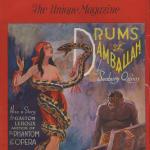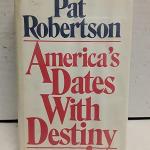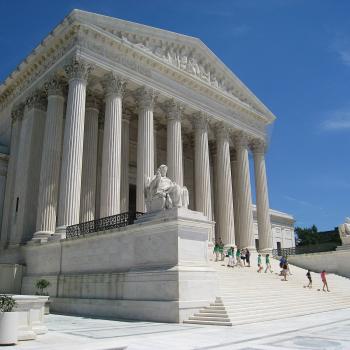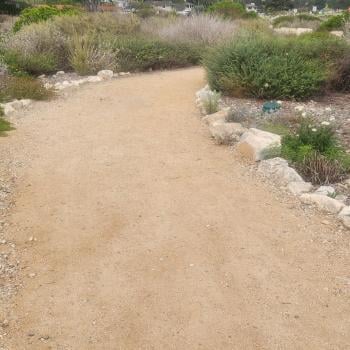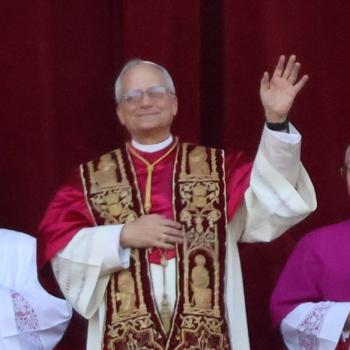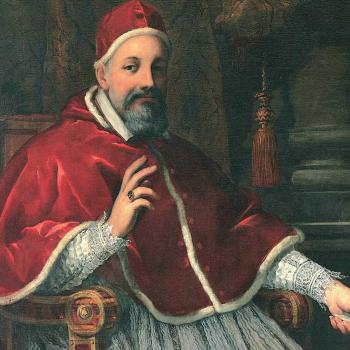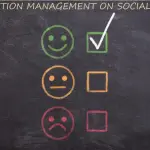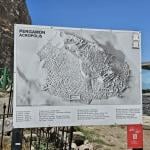A gecko popped its head over the open window to peer at us, its bright green throat tracking its heartbeat. My children squealed with delight as it crept cautiously toward a violet flower balanced on the white windowsill. Rising on its hind legs, the gecko delicately leaned against the rounded glass vase. Through the open window, the wide expanse of Kealakekua Bay on the Big Island spread out below us. It was here that Captain James Cook, a surveyor in the Royal Navy and the first European to establish western contact in the Hawaiian Islands, landed in late January 1779 on this second voyage to these isles. It was also here that Captain Cook met a violent end a few weeks later, stabbed and clubbed to death by incensed locals.
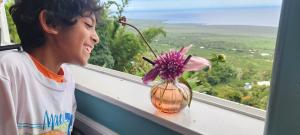
The gecko balancing on the flower vase as my older son looks on gleefully; backdrop is Kealakekua Bay, Big Island of Hawai’i
Gazing out over the crystal waters of Kealakekua Bay toward Cook’s landing point, I was reminded of a trip to Veracruz in 2007 when I gazed out over the Bay of Campeche in the Gulf of Mexico, Hernando Cortés’ entry point to the mainland. Given the 260 years that had passed between Cortés’ landing in 1519 and Cook’s original landing in Kaua’i in 1778, events must had unfolded differently in Hawai’i. I mean, by 1820, when Protestant missionaries officially began preaching Christianity in Hawai’i, Mexico was in the final year of its war of independence from Spain following 300 years of colonial rule. Surely Christians would not have ignored those intervening centuries of history, and would have altered their introduction of Christianity to Hawaiian peoples accordingly, right?
***
Four days ago, my family returned from a fabulous 4-island Hawaiian tour my husband planned: Maui, the Big Island of Hawai’i, O’ahu, then Kaua’i. Through all of our wonderful adventures, educational experiences, and immersion in local history, language, archaeology, and geology, I kept coming back to this question about Christianity in Hawai’i. Given the rich culture of present-day Hawai’i, I wondered whether contemporary native Hawaiians continued to embrace Christianity; per missionary practice, local language, dance, and dress had been banned in the nineteenth century. Many modern Mexicans reject the Catholicism introduced in the sixteenth century, while others remain only culturally Catholic. Was there a similar rejection of Christianity in Hawai’i, I wondered?
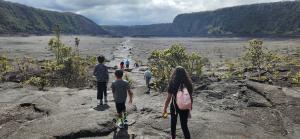
Hiking across the face of a crater with my family, Big Island of Hawai’i
Walking to the car one evening in Maui, I noticed woodcuts of native Hawaiians hanging on a resort wall that were eerily similar to European-produced woodcuts of native peoples in the Americas. There was even one depicting the arrival of Captain Cook that reminded me of European representations of native peoples in the Americas greeting Cortés. It was as if no time had passed, as if native Hawaiians and native peoples in what is now Mexico were interchangeable. It gave me the chills. (I did not take photos).
As we drove around Maui, we passed several houses of worship with signs declaring “Protestant church” in large letters. This surprised me. What, as opposed to a Catholic church? Only later did I notice the name of the denomination in smaller letters. Perhaps the signs are a holdover from when Protestant and Catholic missionaries vied for converts on the islands?
Anxious to learn more about local history and culture, I signed up my family for a free Hawaiian language lesson when we were on the Big Island, our lodgings abutting the ancient royal fish ponds situated among the lava fields near the beach. Not only did I want to learn proper pronunciation as a sign of respect, but also to gain insight into native Hawaiian culture.
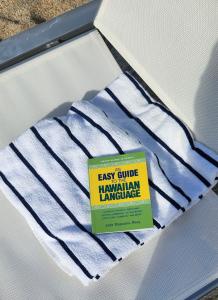
_An Easy Guide to the Hawaiian Language_, which we received as part of our lesson on the Big Island of Hawai’i
Our resort guide, Hokani, a young Hawaiian, directed us to keep our mouths tight as we repeated words and phrases. He told us that his linguistics professors actually taped students’ faces so that they would not open their mouths as widely as when speaking English. Though his great-grandparents spoke Hawaiian, he explained, he had to learn it in college because for generations Hawaiian was discouraged. I asked what the language was like before Europeans alphabetized it and he said it was only oral and that the alphabet went through several iterations. I should have asked about the introduction of Christian concepts into Hawaiian; in colonial Mexico, words with no preexisting terms, like the Trinity, sin, devil, and heaven, proved problematic for Franciscan evangelizers, and I can only imagine missionaries in Hawai’i encountered similar issues.
What I did ask Hokani was if he perceived any contemporary resentment towards, or rejection of, Christianity given its denunciation of aspects of Hawaiian culture. To my surprise, he quickly shook his head. I told him we had discovered that a nearby church offered Mass in Hawaiian and hoped to attend and he nodded, familiar with the church. In fact, he told me, he and his whole family are Catholic. When I raised an eyebrow, he added that almost everyone he knows is Catholic.
I looked past the terrace behind him, hearing families splashing and laughing in the swimming pools below but focusing on the waves in Anaeho’omalu Bay lapping the sand beyond the fish ponds. After a moment, I asked Hokani if he felt that Catholicism was prevalent in Hawai’i because the Catholic Church was more open to native Hawaiian culture than Protestant churches were, and he nodded, smiling shyly. I smiled back.
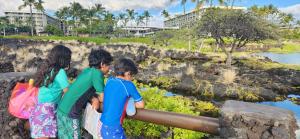
My children gazing into the ancient sacred fish ponds near Anaeho’omalu Bay in Waikoloa, Big Island of Hawai’i
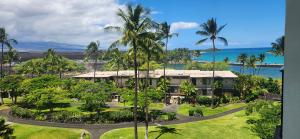
Staying among the lava fields near the ancient sacred fish ponds, Anaeho’omalu Bay in Waikoloa, Big Island of Hawai’i
Hokani’s response reminded me of a favorite assignment of mine in my Latin American history classes, a chapter by historian William Christian Jr. titled simply “Catholicisms” from a 2006 volume, Local Religion in Colonial Mexico. In it, Christian outlines how, supported by canon law, Catholicism takes on the flavor of the local culture. Despite periods of policing and excommunications “… in fact the process of evangelization has generally allowed for an assimilation of local procedures and an accommodation to local holy places and times… [whereas] Protestantism has generally demanded a complete disengagement from the notion of grace invested in objects, images, or places… one of the fundamental ways that Protestants cut themselves free from their Catholic roots…. (260).
I thought about how Latin American historians sometimes wonder how Christian evangelization would have unfolded in the Americas had Protestants arrived before Catholics, demanding that native peoples give up more of their culture and religion than Catholicism demanded. Protestant churches are currently growing in Mexico, partly as a reaction to the limitations placed upon native peoples during the introduction of Catholicism, and partly because those churches are considered to be more aligned with Mexican culture.
If Protestants had arrived to Mexico first, would Mexicans react against it and be more actively Catholic today, as Hawai’i appears to be? There’s no way to know. But it’s an interesting thought.


